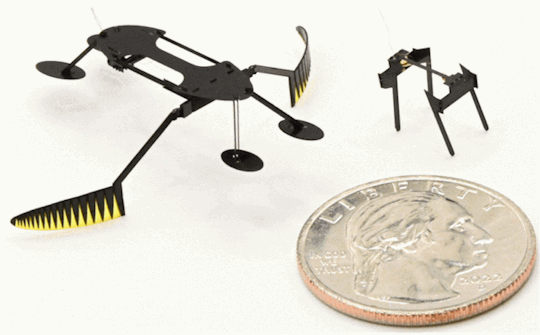#microrobotics
Explore tagged Tumblr posts
Text

Algal Boon
A nebuliser system for delivering drug-loaded microrobots, which in this study are green algae-based, homogeneously throughout the lung for effective treatment of respiratory diseases. Seen here, a falsely-coloured scanning electron microscope image of an algae robot poised with its drug-loaded nanoparticles (orange)
Read the published research article here
Image from work by Zhengxing Li, Zhongyuan Guo, Fangyu Zhang and Lei Sun, and colleagues
Aiiso Yufeng Li Family Department of Chemical and Nano Engineering, University of California San Diego, La Jolla, CA, USA
Image contributed by the authors under a Creative Commons Attribution 4.0 International (CC BY 4.0) licence
Published in Nature Communications, January 2025
You can also follow BPoD on Instagram, Twitter, Facebook and Bluesky
#science#biomedicine#biology#electron microscopy#algae#nanoparticles#drug delivery#microrobots#nebuliser
7 notes
·
View notes
Text

Two insect-like robots, a mini-bug and a water strider may be the smallest, lightest and fastest fully functional micro-robots ever known to be created. Such miniature robots could someday be used for work in areas such as artificial pollination, search and rescue, environmental monitoring, micro-fabrication or robotic-assisted surgery. Reporting on their work in the proceedings of the IEEE Robotics and Automation Society's International Conference on Intelligent Robots and Systems, the mini-bug weighs in at eight milligrams while the water strider weighs 55 milligrams. Both can move at about six millimeters a second.
...
Both can move at about six millimeters a second.
"That is fast compared to other micro-robots at this scale although it still lags behind their biological relatives," said Conor Trygstad, a PhD student in the School of Mechanical and Materials Engineering and lead author on the work.
An ant typically weighs up to five milligrams and can move at almost a meter per second.
The key to the tiny robots is their tiny actuators that make the robots move.
Trygstad used a new fabrication technique to miniaturize the actuator down to less than a milligram, the smallest ever known to have been made.
"The actuators are the smallest and fastest ever developed for micro-robotics," said Néstor O. Pérez-Arancibia, Flaherty Associate Professor in Engineering at WSU's School of Mechanical and Materials Engineering who led the project.
The actuator uses a material called a shape memory alloy that is able to change shapes when it's heated
#robotics#biomimicry#microrobots#engineering#mechanical engineering#materials science#Material engineering#Shape memory alloy
2 notes
·
View notes
Text
Light-powered phagocytic macrophage microrobot combines immune functions with robotic controllability
Macrophages and other immune cells are the natural frontline immune warriors of our body, defending the body against invading pathogens and cancer cells. Yet despite their innate “combat” capabilities, precisely directing and activating these cells in vivo has remained challenging. In recent years, the emergence of bio-microrobots has shown great potential to convert these “natural soldiers” into…

View On WordPress
0 notes
Text
𝐌𝐢𝐜𝐫𝐨𝐬𝐜𝐨𝐩𝐢𝐜 𝐑𝐨𝐛𝐨𝐭𝐬 𝐍𝐨𝐰 𝐒𝐰𝐢𝐦 𝐈𝐧 𝐘𝐨𝐮𝐫 𝐁𝐥𝐨𝐨𝐝?!
Tiny robots that swim through your bloodstream are no longer science fiction. This MedTech breakthrough could replace pills, surgeries, and side effects—forever. Watch this to see how the future of healthcare is already here.
Watch https://youtube.com/shorts/0Nxg604uTks?feature=share
#MedTech#NanoRobots#AIInMedicine#FutureOfHealthcare#MicroRobots#BiomedicalInnovation#YouTubeShorts#TechInHealth#MedicalBreakthrough#RobotDoctors#fraoula
0 notes
Text
Ant-Inspired Robots: Lifting Heavy Objects & Navigating Tight Spaces | Aakash Khurana | Researchatory.AI | BioWonders.Odyssey
Tiny robots, big potential! These ant-inspired microrobots could revolutionize industries from medicine to manufacturing. Imagine targeted drug delivery, precise assembly, and even environmental cleanup, all thanks to the power of collective robotics. #robotics #microrobots #medicine #manufacturing #environmentalcleanup #technology #innovation #engineering #futureoftechnology #science #swarmrobotics #artificialintelligence #ai #research #korea
Scientists in South Korea have developed tiny, magnetic robots that can work together like ants to achieve impressive feats. These microrobots, inspired by the collaborative behavior of ants, can lift heavy objects, traverse challenging terrains, and even clear blocked tubes.
The robots are controlled by a rotating magnetic field, which allows them to coordinate their movements and perform complex tasks that would be impossible for a single robot. For example, a swarm of these robots can form a raft to float on water and carry objects much larger than themselves. They can also climb obstacles and navigate through tight spaces.
The potential applications for these microrobots are vast. They could be used in medicine to deliver drugs or perform minimally invasive surgery. They could also be used in manufacturing to assemble small parts or in environmental cleanup to remove pollutants.
While the technology is still in its early stages, the development of these microrobots is a significant step forward in the field of robotics. Their ability to work together and perform complex tasks has the potential to revolutionize many industries.
For more info:
https://www.cell.com/device/fulltext/S2666-9986(24)00583-0
#research#science#robots#robotics#microrobots#medicine#manufacturing#environmentalcleanup#technology#innovation#engineering#futureoftechnology#swarmrobotics#artificialintelligence#ai#korea
0 notes
Text
instagram
0 notes
Text
Sie transportieren #Embryonen und bekämpfen #Krebszellen: Wie Nanoroboter heilen könnten
Die Illustration eines #Nanoroboters an einer Krebszelle
Noch ist ihr Einsatz im menschlichen Körper eine Zukunftsvision: ein #Mikroroboter bekämpft #Krebszellen
0 notes
Text
COLMENA, UNAM's lunar marvel, launches Jan 8 with microrobots breaking space size records. A Mexican space odyssey led by 250 young minds aims to conquer the Moon's challenges and revolutionize cosmic exploration.
0 notes
Text






Zero2 Microrobot (1985) by David Buckley, Intergalactic Robots Ltd. (IGR), London, UK. Zero2 is a precision robot turtle available in kit form from Maplin Electronics. "What is ZERO 2? Is it a turtle? - Yes! Is it a robot vehicle? Yes! Is it even another buggy? Yes! ZERO 2 is all of these and much more besides; it is whatever you want it to be. While the idea of electronically controlled robot vehicles is by no means new, it is only in the past few years with the widespread use of microcomputers that it has become a practicality. One of the most frequent questions asked about computer controlled robot vehicles is: "What can you do with it?" However, no one asks the same about a ball - they have been around for such a long time that everyone knows. ZERO 2 in its primary mode has a built-in function; that of drawing Logo graphics but it is also equipped with LED's to be turned on and off, a two-tone horn that can be sounded and a line- follower. Add-on boards provide speech, obstacle detection and hole sensing so that it doesn't fall off the edge of the table. Like a ball, what you actually do with ZERO 2 is up to you." – ZERO2, Electronics - The Maplin Magazine, March to May 1985.
18 notes
·
View notes
Text

Harnessing magnetic relaxation: 'Pac-Man effect' enables precise organization of superparamagnetic beads
Particles that are larger than regular molecules or atoms yet remain invisible to the naked eye can form a variety of useful structures, including miniature propellers for microrobots, cellular probes, and steerable microwheels designed for targeted drug delivery. Lisa Biswal's team of chemical engineers at Rice University has found that exposing a certain class of such particles—micron-sized beads endowed with a special magnetic sensitivity—to a rapidly alternating, rotating magnetic field causes them to organize into structures that are direction-dependent or anisotropic. This discovery is important because anisotropy can be adjusted to develop new, customizable material structures and properties.
Read more.
16 notes
·
View notes
Note
im sure youll be delighted to know
https://www.technologyreview.com/2023/12/08/1084696/medical-microrobots-are-still-on-their-way/

JIZZ DELIVERY ROBOTS?!?!?
8 notes
·
View notes
Text
Zhero Microrobot and Alien Visitor handheld LCD generic games
#blacktubbootlegs#bootleg#lcd#motu#game design#video games#tiger electronics#bootlegs#vintage#handheld#watch
5 notes
·
View notes
Link
4 notes
·
View notes
Text
Medical microrobots that can travel inside your body are (still) on their way
2 notes
·
View notes
Text
Additionally: This was, in fact, part of efforts to cure disease! This microscopic 3d-printed model was created as part of a study on "microswimmers" - tiny objects that move well in fluid environments - to create better delivery mechanisms for medicines.
“By studying synthetic microswimmers, we would like to understand biological microswimmers,” Samia Ouhajji, one of the study’s authors, told CNN. “This understanding could aid in developing new drug delivery vehicles; for example, microrobots that swim autonomously and deliver drugs at the desired location in the human body.”
It's also helping them learn things like how bacteria and sperm move through the body, having implications for treatment of bacterial infections and reproductive issues.
oh dang, it's gonna take them even longer to get home in that

[Image description a news screenshot reading "Physicists make tiny model of Star Trek's USS Voyager that's smaller than a human hair"]
39K notes
·
View notes
